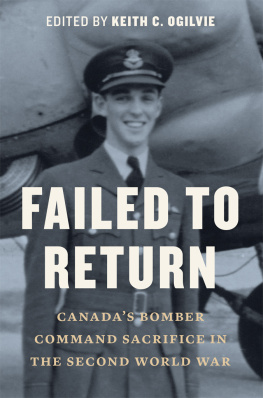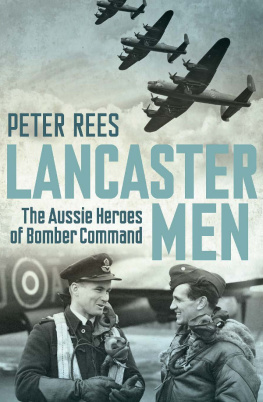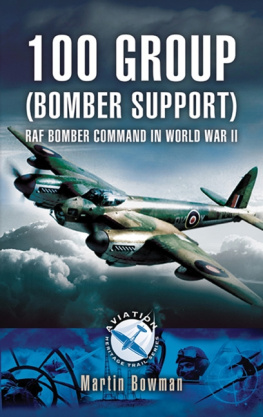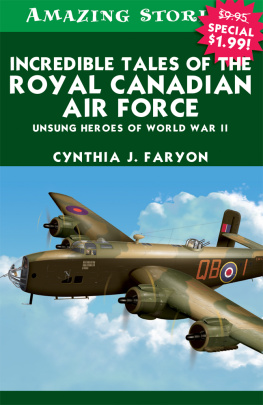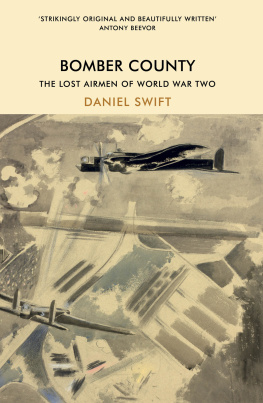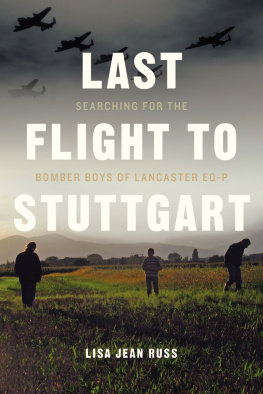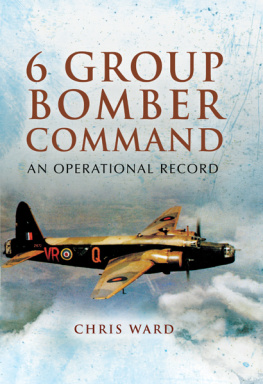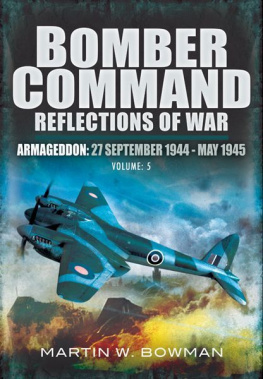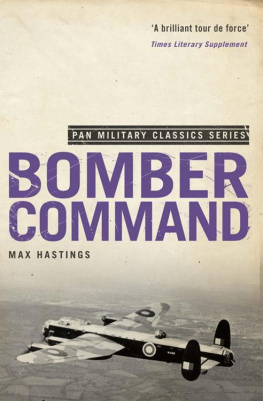Copyright 2021 Keith C. Ogilvie
Individual chapters copyright 2021 Steve Bond, Steve Darlow, Linzee Druce, Sean Feast, Marc Hall, Keith C. Ogilvie, Robert Owen, Howard Sandall
All rights reserved. No part of this publication may be reproduced, stored in a retrieval system, or transmitted in any form or by any meanselectronic, mechanical, audio recording, or otherwisewithout the written permission of the publisher or a licence from Access Copyright, Toronto, Canada.
Heritage House Publishing Company Ltd.
heritagehouse.ca
Some of the text in this anthology originally appeared in Bomber Command: Failed to Return and Bomber Command: Failed to Return II, both published in the United Kingdom in 2012 by Fighting High Publishing, and have been edited and reproduced in this volume, with permission from the original publisher and contributors.
Cataloguing information available from
Library and Archives Canada
978-1-77203-381-6 (paperback)
978-1-77203-382-3 (ebook)
Copyedited by Warren Layberry
Proofread by Nandini Thaker
Cover and interior book design by Setareh Ashrafologhalai
Cover photograph: Teddy Blenkinsop in front of an Avro Anson at No. 4 SFTS. With permission from the Blenkinsop family, via John Neroutsos and Peter Celis.
The interior of this book was produced on 100% post-consumer recycled paper, recycled chlorine free, and printed with vegetable-based inks.
Heritage House gratefully acknowledges that the land on which we live and work is within the traditional territories of the Lkwungen (Esquimalt and Songhees), Malahat, Pacheedaht, Scianew, TSou-ke, and W SNE (Pauquachin, Tsartlip, Tsawout, Tseycum) Peoples.
We acknowledge the financial support of the Government of Canada through the Canada Book Fund (CBF) and the Canada Council for the Arts, and the Province of British Columbia through the British Columbia Arts Council and the Book Publishing Tax Credit.

25 24 23 22 21 1 2 3 4 5
Printed in Canada
One day... it will be recorded that when human society stood at the crossroads and civilization itself was under siege, the Royal Canadian Air Force was there to fill the breach and help give humanity the victory. And all those who had a part in it will have left to posterity a legacy of honour, of courage and of valour that time can never despoil.
FATHER J.P. LARDIE Chaplain for 419, 428 Squadrons, RCAF Inscribed on the Bomber Command Memorial Wall in Nanton, Alberta
CONTENTS
LINZEE DRUCE
STEVE DARLOW
SEAN FEAST
ROBERT OWEN
HOWARD SANDALL
STEVE DARLOW
KEITH C. OGILVIE
MARC HALL
MARC HALL
SEAN FEAST
HOWARD SANDALL
MARC HALL
MARC HALL
STEVE BOND
STEVE DARLOW
FOREWORD
MOST OF THE stories related in this book were originally published in the United Kingdom as part of the Failed to Return series of books released by Fighting High Publishing. These books chronicled the fates of the unfortunate crews of the Royal Air Forces Bomber Command who did not come back from campaigns on German industrial centres, supporting D-Day operations, with the Dam Busters, against the Nazi V-weapons, and ultimately, against the heart of the Reich, Berlin.
Canada and Canadians made two very significant contributions to Bomber Command: by training about half of Bomber Commands aircrews in Canada and by providing, from Canadian cities, towns, farms, and countryside, a quarter of the men who undertook these dangerous assignments. This volume gathers the stories of individual young Canadians whose names and contributions should not be forgotten.
The authors are acclaimed historians and writers of military history who have drawn from family archives and records, wartime memoirs, logbooks and official combat records, diaries and letters, and on rare occasions, the personal testimony of men who were party to the events described. From these disparate sources, they have stitched together the remarkable and tragic stories set out in this volume. The introduction sets out the Canadian context for these stories, with background on the British Commonwealth Air Training Plan (BCATP)under which most of those whose names appear herein were trained for warand a description of how the RCAF grew up from a small, dated, and underequipped force in 1939 to one of the largest air forces in the world by the end of the war. A new chapter, previously unpublished, recounts the story of S/L Teddy Blenkinsop, a native of Victoria, BC, whose tragic fate is not well known in his home province and country.
KEITH C. OGILVIE
November 2021
INTRODUCTION
THE AERODROME OF DEMOCRACY
FIRST, THE SHOCKING statistics. In the end, over a quarter of the 125,000 aircrew who served in Royal Air Force (RAF) Bomber Command during the Second World War were members of the Royal Canadian Air Force (RCAF), flying with RAF units or increasingly, as the War progressed, in RCAF Squadrons. The horrific rate of loss across Bomber Command45 percent of aircrew killed outright, 6 percent seriously wounded, and another 8 percent taken as prisoners of warwas equally felt by Canadians, whether they flew in RCAF squadrons or were attached to the RAF. Attrition rates werent shared with operational aircrews as they flew, fought for their lives, and slowly tallied the missions they survived, but the ones who did return had ample evidence in the heartfelt absence of squadron comrades who had not been so lucky. Squadron Operations Records systematically and impartially recorded the aircraft number, crew names, mission, time of takeoff, and for the unfortunate few, a brief and poignant notation in the column that would normally describe the assessed results: Failed to return. Nothing heard from this aircraft following takeoff.
Despite the burden of these tragic losses, night after night, flyers continued to prepare themselves mentally and physically for long and tense combat missions, often on several consecutive nights, repeatedly performing their personal good luck rituals and climbing into the narrow airframes that would take them into unforgiving skies over enemy territory.
By 1945, some 40,000 Canadians had served in operational squadrons or training units of RAF Bomber Command. Nearly 10,000 of these young Canadians would give up their lives before the end of hostilities in 1945. They were volunteers, most aged nineteen to twenty-five, with limited experience of life, and none with any idea that he stood only a forty percent chance of coming home whole from the task for which he had volunteered.
Where did they come from, these young men with vague, idealistic, and sometimes romanticized visions of waging a righteous war miles in the air against a dangerous enemy? How were they molded and trained to operate the most complex and lethal weapons of war of the time? How did they learn the essential skills and self-discipline so that, barely out of their teenaged years, they could take command of a state-of-the-art, eighteen-ton, four-engined aircraft along with six other young men and carrying as much as ten tons of bombs and aviation fuel through hostile airspace bristling with flak, enemy fighters, and often, foul weather, to a precise target somewhere in Europe?

